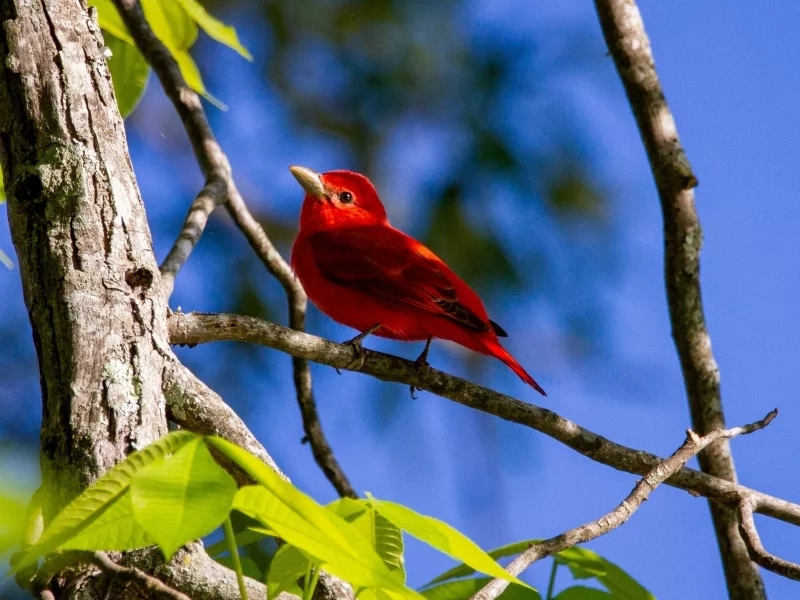News and Testimonials

Fun Hepatic Tanager Facts For Kids
Do you like watching birds fly high in the sky? There are different birds that come in different colors and fly across. One such bird is the hepatic tanager (Piranga flava) which is very colorful and a small bird. The hepatic tanager (Piranga flava) is often confused with the Summer Tanager, but when you compare hepatic tanager vs summer tanager, you will see that the summer tanager has a longer tail and shorter bill than the hepatic tanager. Hepatic tanager birds belong to the order Passeriformes, family Cardinalidae, and genus Piranga.
The male hepatic tanager is brick red in color with a gray bill, flank, and cheek patch. The female hepatic tanager has a brighter yellow throat with gray underparts. Here are some of the most interesting facts about the hepatic tanager, afterward do read our other articles on chipping sparrow and golden cheeked warbler as well.
What Type Of Animal Is A Hepatic Tanager?
The hepatic tanager (piranga flava) is a type of bird that is small in size and the color varies in males and females and also juvenile birds. This bird species can be mostly found in Central and South America. As a matter of fact, there are more than 300 Tanager species that can be found in Central and South America.
What Class Of Animal Does A Hepatic Tanager Belong To?
Hepatic tanagers belong to the class of birds and are very colorful in their appearance. They belong to birds belong to order Passeriformes, family Cardinalidae, and genus Piranga. It is a bird that is medium in size and has a bill that is short and heavy. Adults are grayish, brick red, in color and females are olive yellow in color and their size differs accordingly.
How Many Hepatic Tanagers Are There In The World?
There is no specific number for how many hepatic tanagers are there in the world. The population keeps changing.
Where Does A Hepatic Tanager Live?
Hepatic tanagers live in much of South and Central America and often migrate to the southwestern U.S. where these birds of North America can be found across a wide geographical range.
What Is A Hepatic Tanager's Habitat?
The hepatic tanager’s habitat includes the open pine and pine oak forests and lives in habitats that are highland. These birds of North America are mostly found in areas that are open. Hepatic tanagers that migrate can also be found in the woodlands, desert oases, and wooded stream corridors across South America and Central America, as far as Costa Rica.
Who Do Hepatic Tanagers Live With?
Like other birds from similar species, hepatic tanagers prefer to live alone and come together only during the mating season to mate with the females. Like other North American birds from similar species, this species likes to live alone rather than living with pairs or with family.
How Long Does A Hepatic Tanager Live?
Hepatic tanagers are said to live for a span of five years depending on different factors which determine their lifespan. Some live for many years whereas some live for a short period of time depending on the factors such as climate change, food, and many other factors.
How Do They Reproduce?
The breeding season of hepatic tanagers takes place between mid May to early June, like the Summer Tanager. During the breeding season, the male hepatic tanager uses a silent courtship which displays in which they fly to the branches that are exposed below a hepatic tanager female and also then extend their wings and their neck to show off their bright red back. The building of their nest and also the laying of the eggs occurs usually in less than two weeks after the adults arrive during the breeding season. The nest is a cup built of grasses and weed stems. The average clutch size for these birds is three to five eggs during the entire breeding season.
What Is Their Conservation Status?
The conservation status of hepatic tanagers is of Least Concern, that is their population keeps increasing with the increase in their numbers. The number of hepatic tanagers keeps changing based on different factors.
How Do They Communicate?
Hepatic tanagers communicate with each other with the use of songs, calls, and also physical displays. Males sing and chase the rival males in order to defend their territory. These birds from the cardinal family counter sing at the beginning of the breeding season.
How Big Is A Hepatic Tanager?
Hepatic tanagers are very small in size as compared to the other birds from similar species. Their average size is around 8 in (20.3 cm) and their wingspan is around 12.0-12.5 in (30.4-31.7 cm).
How Fast Can A Hepatic Tanager Fly?
There is no mention of accurate speed so as to how fast a hepatic tanager can fly. These birds tend to fly fast when they see their predator following them.
How Much Does A Hepatic Tanager Weigh?
The hepatic tanager's range of weight is around 1.3 oz (0.03 kg) as they are very small in size and the weight varies according to the body structure.
What Are The Male And Female Names Of The Species?
There is no specific or particular name for the male and the female species of hepatic tanager. Hence, they are known as male hepatic tanager and female hepatic tanager respectively.
Source: https://beaglebirding.com/admin/index.php?module=novedades&view=novedad&action=add




